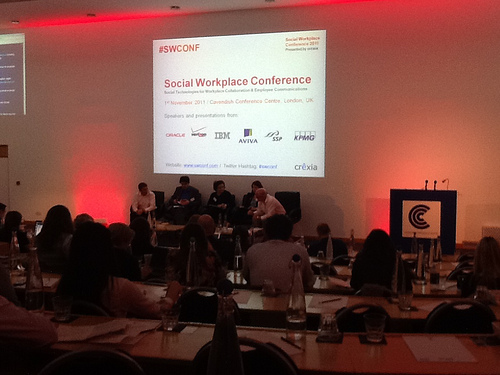I had the privilege of speaking at The Social Media Workplace conference in London today. A well organised, wonderfully targeted event, looking at how Social Software can build the Social Workplace. Lots of conversations about how’s and why’s, without getting tied up in knots arguing about definitions. Here is my talk, inspired by what we’ve learnt with Milestone Planner and the tools we’ve build these past few years, redacted and reduced to it’s key points:
Not everyone is a Social Software enthusiast. In fact, some people are down right hostile to it, for all sorts of reasons. The word ‘social’ has baggage, we have to deal with that. The telephone received many of the same objections…
- “Well-informed people know it is impossible to transmit the voice over wires. Even if it were, it would be of no practical value.” – Boston Post, 1865
- “This ‘telephone’ has too many shortcomings to be seriously considered as a means of communication. The device is inherently of no value to us.” Western Union internal memo, 1876
- “Why would any person want to use this ungainly and impractical device when he can send a messenger to a local telegraph office and have a clear written message sent to any large city in the United States?” report to the President of Western Union written by the committee charged with investigating potential purchase of Bell’s telephone patent for $100,000
Many IT roll outs fail simply because people stopped believing in the project. Not convinced? Try spreading a rumour that your current favourite project isn’t going so well, and watch how quickly support for it gets dropped, and how hard getting it done becomes! Visible buy in from the leadership team is essential in the long run.
Collaboration isn’t a hobby, it’s a business necessity, especially in challenging times like these than need innovation. When you start with a new tool, think about what your evidence of success will be – how will you know it’s working out? What will you see or observe? Don’t get hung up on quantitative measures, numbers are interesting, but vision is compelling.
Have a strategy that can be broken down into small parts and executed quickly – we think about plans and milestones – build the plan, work out the first milestone, work out the first action. Think Big, Move Fast, Act Small.
There are three types of communication in an organisation, and they are also stages towards social collaboration:
- Broadcast (telling)
- Feedback (responding)
- Conversation (engaging)
- Networks (engaged)
These mirror the journey of mass media, from traditional (broadcast – interruption) to digital (on-line – engagement) to social (networked – advocacy). Sharing needs to be part of the company culture. Tools can help with that, but the tools need cultural support from the business leaders.
Collaboration is nothing new – we’ve been doing it for rather a long time! What is new is the way that technology has taken “distance” out of the equation. We can collaborate and plan together, even if we are on opposite sides of the world, jet lag permitting. Collaboration is more about language and people, not about process and data. It is structurally different:
Consensus versus Command & Control
- Qualitative versus Quantitative (tags & comments)
- People over Process (the social graph is the workflow)
- Sharing over Filing (people will get data where it needs to be).
This is about data in motion, rather than data at rest – a moving conversation, rather than a static file archive. Social software thrives on communities, but many businesses have built audiences. An audience is not a community, it lacks the cohesion and sense of purpose that defines a community. Social software also needs a purpose. A great tool, without a reason, is the poorest kind of tool, and won’t get adopted. Understand why you want to use the software, and what you want to achieve with it.
A recent response on Quora to the question: “Which is the simplest collaborative project management tool?” quipped “A meeting.” – and indeed, there’s no point using technology for technology’s sake, but software software does fix the issues of distance (remove working), evidence (capturing the outputs) and structure!


Trackbacks/Pingbacks